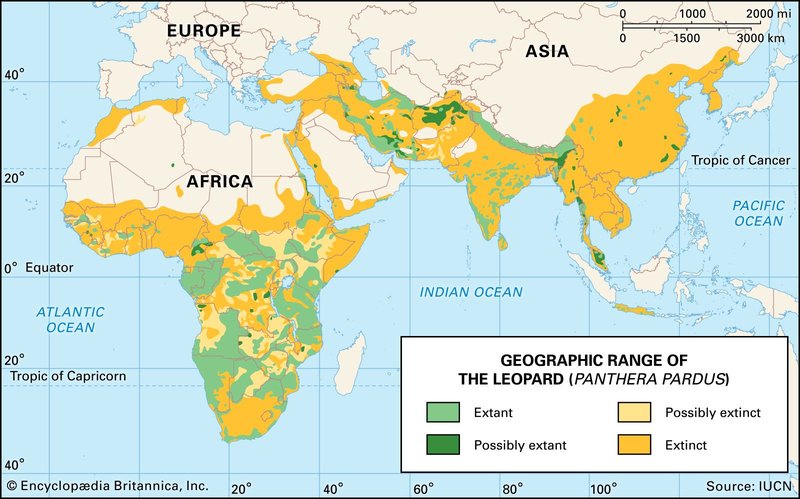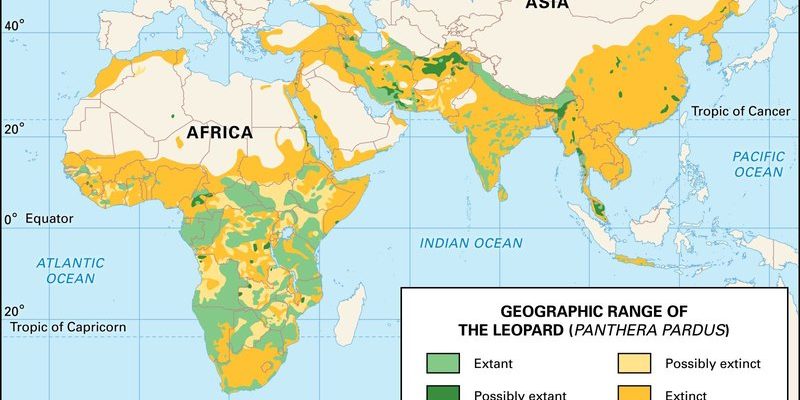
Leopards are some of the most adaptable big cats on the planet, thriving in a variety of environments. Their habitats range from dense jungles to open savannahs, and even rugged mountains. It’s almost like they’re the “Jack of all trades” in the animal kingdom. Let’s dive into the fascinating world of leopard habitats and distribution!
Understanding Leopard Habitats
Leopards are masters of adaptability, which means they can thrive in various habitats. Their preference often boils down to a few key factors—food availability, shelter, and water sources. Here’s the thing: whether it’s the lush rainforest or the arid desert, they find a way to make it work.
Most commonly, leopards are found in savannas, where the mix of open land and scattered trees provides the perfect hunting ground. They can easily blend into the tall grasses, using their spotted coats as natural camouflage. In fact, watching a leopard stalk its prey, nearly invisible until the very last moment, is a testament to their hunting skills.
But that’s not all. Leopards also make homes in forests, especially tropical and subtropical regions. These lush locales are teeming with life—think monkeys, birds, and plenty of other animals. The dense foliage gives leopards excellent cover while they hunt, making it an ideal setting for these big cats.
Global Distribution of Leopards
Leopards have a broad geographic range that stretches across much of Africa and parts of Asia. They’re not just confined to one area but have adapted to thrive in various countries. You might be wondering, “Where exactly can I find these magnificent creatures?”
In Africa, leopards inhabit a large chunk of the continent, from the serengeti plains of Tanzania to the bushveld of South Africa. They’re often found in protected reserves, where they can roam freely without the threat of poaching or human encroachment. However, Africa isn’t the only place you’ll find them.
In Asia, leopards inhabit regions stretching from India to Siberia. Yes, Siberia! The Amur leopard, a critically endangered subspecies, calls this cold region home. They’ve adapted to the harsh climate there, showcasing how resilient these animals are.
Preferred Habitats: Key Features
So what makes a habitat particularly appealing to leopards? There are a few key features that they look for when choosing where to set up shop.
First, the availability of prey is crucial. Leopards are carnivores, so they feast on various animals, including deer, antelope, and even small mammals like rodents. They need environments where these prey animals are plentiful. A habitat lacking in food sources isn’t going to work out well for a leopard.
Next, consider shelter. Leopards are solitary creatures that enjoy the solitude of dense cover. This could mean hiding in tall grasses, thick brush, or even trees. They often drag their kills up into trees to keep them away from scavengers, so having access to sturdy branches is a plus.
Finally, water sources matter. Leopards are adept at surviving without much water, but they still need access to it. This means habitats with nearby rivers, lakes, or even seasonal streams are more attractive. They can quench their thirst and find prey that comes to drink.
The Impact of Human Activity
As with many wild animals, human activity poses a threat to leopard habitats. Urban expansion, agriculture, and infrastructure development lead to habitat destruction. As leopards lose their homes, they face challenges finding food and shelter.
Poaching is another significant concern. Leopards are hunted for their beautiful pelts, and this illegal activity has drastically reduced their populations in certain areas. Conservation efforts are vital to ensure these amazing animals continue to thrive in the wild.
In some regions, wildlife reserves and national parks have been established to protect leopards and their habitats. These areas not only help conserve the species but also boost local tourism. People flock to see leopards in their natural habitat, which brings in revenue that can be reinvested in conservation.
Unique Adaptations of Leopards
Leopards are incredibly adaptable creatures, and their abilities have allowed them to thrive in various environments. One of their most remarkable traits is their climbing ability. Unlike many other big cats, leopards are skilled climbers and often take to trees to avoid larger predators, store food, or even rest.
Their nocturnal behavior is another fascinating adaptation. Leopards tend to be more active at night, allowing them to hunt with less competition. This helps them stay safe and increases their chances of catching prey.
Additionally, leopards have a highly developed sense of hearing and sight, which makes them excellent hunters. They can pinpoint the slightest rustle of a mouse in the grass or spot a distant gazelle from a high perch in a tree.
Conservation Efforts and Future Outlook
The future of leopards depends significantly on conservation efforts worldwide. Organizations are working hard to educate communities, protect habitats, and ensure these incredible animals have a fighting chance.
One effective approach is community-based conservation, where local people are involved in protecting wildlife. This method encourages residents to value leopards and see them as assets rather than threats. With proper education and resources, communities can learn to coexist with these majestic cats.
Additionally, habitat restoration projects aim to rehabilitate areas that have been devastated by human activity. Replanting native vegetation and creating wildlife corridors can help leopards move freely between habitats. This increases their chances of survival and allows populations to thrive.
Leopards are remarkable creatures with diverse habitats spanning across continents. From the savannahs of Africa to the forests of Asia, they embody adaptability in every sense. These incredible animals face challenges due to human activity, but with ongoing conservation efforts, there’s hope for their future.
The story of the leopard is one of survival and resilience. Each sighting of a leopard in the wild is not just a glimpse at nature’s beauty but a reminder of the importance of protecting our planet’s wildlife. So next time you think of leopards, remember their wonderful homes and the efforts needed to keep them thriving.

